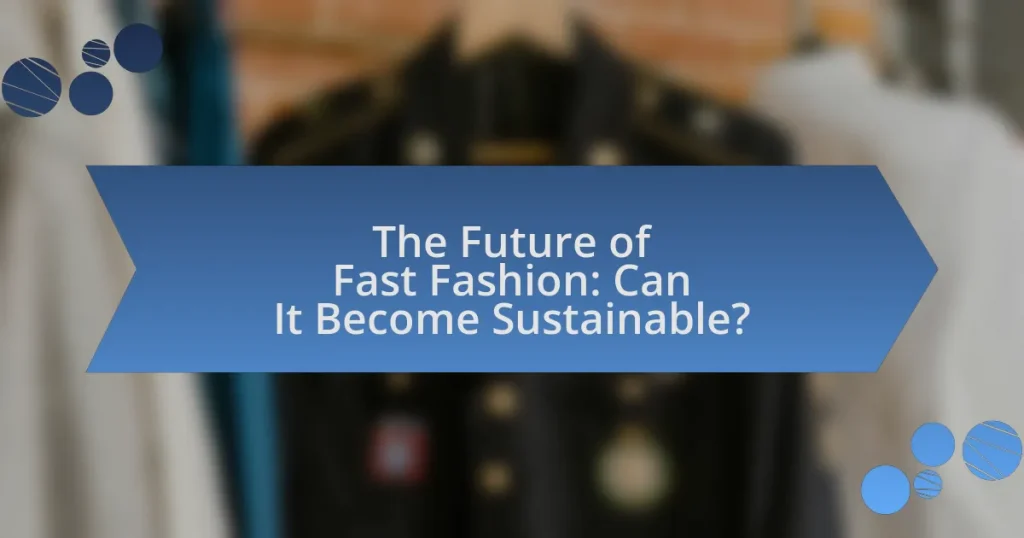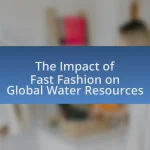Fast fashion is characterized by the rapid production of low-cost clothing to meet current trends, leading to significant environmental impacts such as pollution, waste, and resource depletion. The industry is responsible for 10% of global carbon emissions and generates approximately 92 million tons of textile waste annually, straining waste management systems. This article explores the environmental degradation caused by fast fashion, the importance of sustainability, and the challenges brands face in implementing eco-friendly practices. It also discusses the role of consumer behavior in driving demand for sustainable options and highlights innovative practices and technologies that can aid in creating a more sustainable fashion industry.
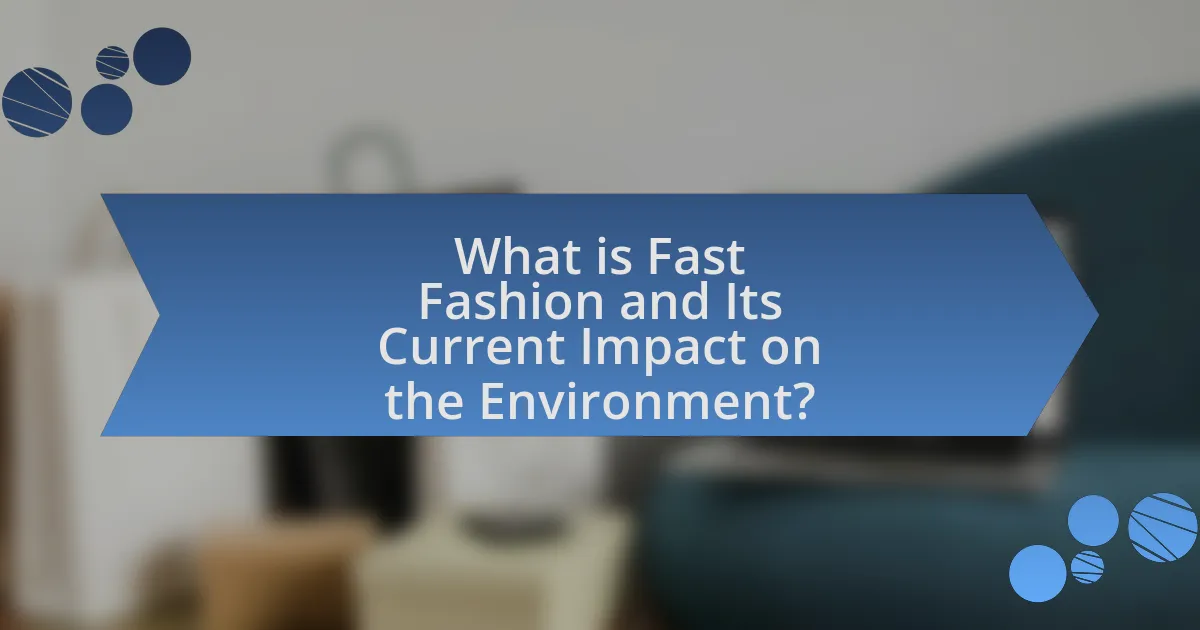
What is Fast Fashion and Its Current Impact on the Environment?
Fast fashion refers to the rapid production of inexpensive clothing to meet the latest trends, resulting in a cycle of quick consumption and disposal. This industry significantly impacts the environment by contributing to pollution, waste, and resource depletion. For instance, the fashion industry is responsible for 10% of global carbon emissions and is the second-largest consumer of water, with the production of a single cotton shirt requiring approximately 2,700 liters of water. Additionally, fast fashion generates massive textile waste, with an estimated 92 million tons discarded annually, much of which ends up in landfills. These statistics highlight the urgent need for sustainable practices within the fashion industry to mitigate its environmental footprint.
How does fast fashion contribute to environmental degradation?
Fast fashion contributes to environmental degradation primarily through excessive resource consumption and waste generation. The industry relies on the rapid production of low-cost clothing, which leads to significant water usage; for instance, producing a single cotton t-shirt can require up to 2,700 liters of water. Additionally, fast fashion generates substantial textile waste, with an estimated 92 million tons of textiles discarded annually, much of which ends up in landfills. The production processes also involve harmful chemicals that can pollute water sources, further exacerbating environmental harm.
What are the primary environmental issues caused by fast fashion?
The primary environmental issues caused by fast fashion include excessive waste generation, water pollution, and high carbon emissions. Fast fashion brands produce millions of garments each year, leading to approximately 92 million tons of textile waste annually, much of which ends up in landfills. Additionally, the production processes often involve toxic dyes and chemicals that contaminate water sources, affecting ecosystems and human health. Furthermore, the fast fashion industry is responsible for about 10% of global carbon emissions, primarily due to energy-intensive manufacturing and transportation practices. These statistics highlight the significant environmental impact of fast fashion, underscoring the urgent need for sustainable practices in the industry.
How does fast fashion affect waste management systems?
Fast fashion significantly strains waste management systems by increasing textile waste and complicating recycling processes. The fast fashion industry produces approximately 92 million tons of textile waste annually, much of which ends up in landfills due to the low quality and non-recyclable materials used in these garments. This influx of waste overwhelms existing waste management infrastructures, which are often ill-equipped to handle the volume and type of materials generated by fast fashion. Furthermore, the rapid turnover of clothing styles leads to a culture of disposability, where consumers discard items after minimal use, exacerbating the waste crisis.
Why is sustainability important in the fashion industry?
Sustainability is important in the fashion industry because it addresses environmental degradation, social inequality, and economic viability. The fashion industry is one of the largest polluters globally, contributing to 10% of annual carbon emissions and significant water waste, with the production of a single cotton shirt requiring approximately 2,700 liters of water. By adopting sustainable practices, such as using eco-friendly materials and ethical labor practices, the industry can reduce its ecological footprint and promote social responsibility. Furthermore, consumer demand for sustainable products is rising, with 66% of global consumers willing to pay more for sustainable brands, indicating a market shift towards sustainability that can drive long-term profitability.
What are the long-term effects of unsustainable practices in fashion?
The long-term effects of unsustainable practices in fashion include environmental degradation, social inequality, and economic instability. Environmental degradation manifests through pollution, resource depletion, and biodiversity loss, as the fashion industry is responsible for 10% of global carbon emissions and significant water usage, with the production of a single cotton t-shirt requiring approximately 2,700 liters of water. Social inequality arises from exploitative labor practices, where workers in developing countries often face poor working conditions and low wages, contributing to a cycle of poverty. Economic instability is evident as unsustainable practices can lead to market volatility and increased costs associated with environmental cleanup and regulatory compliance. These interconnected issues highlight the urgent need for sustainable practices in the fashion industry to mitigate long-term negative impacts.
How does consumer behavior influence sustainability in fashion?
Consumer behavior significantly influences sustainability in fashion by driving demand for eco-friendly products and practices. When consumers prioritize sustainable brands, companies are compelled to adopt environmentally responsible practices, such as using organic materials and reducing waste. For instance, a 2021 survey by McKinsey found that 67% of consumers consider sustainability when making a purchase, indicating a strong market preference for sustainable options. This shift in consumer preferences encourages brands to innovate and invest in sustainable technologies, ultimately leading to a more sustainable fashion industry.
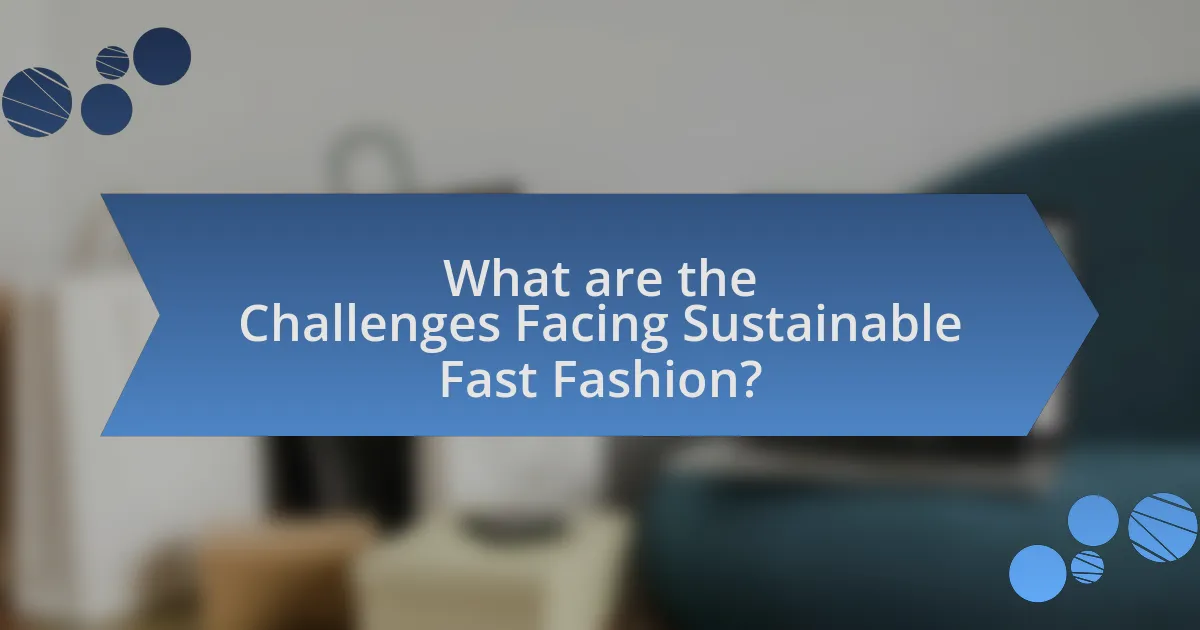
What are the Challenges Facing Sustainable Fast Fashion?
Sustainable fast fashion faces several significant challenges, including the high cost of sustainable materials, consumer demand for low prices, and the rapid pace of production cycles. The use of eco-friendly materials often results in increased production costs, which can deter brands from adopting sustainable practices. Additionally, consumers frequently prioritize affordability over sustainability, leading to a preference for cheaper, conventional fast fashion items. The fast fashion industry is characterized by quick turnaround times, making it difficult for brands to implement sustainable practices without disrupting their supply chains. These challenges are compounded by the lack of industry-wide standards for sustainability, which creates confusion for both consumers and brands regarding what constitutes truly sustainable fashion.
What obstacles do brands encounter when trying to implement sustainable practices?
Brands encounter several obstacles when trying to implement sustainable practices, primarily including high costs, supply chain complexities, and consumer demand for low prices. High costs arise from the need for investment in sustainable materials and technologies, which can significantly increase production expenses. Supply chain complexities involve the challenge of sourcing sustainable materials and ensuring ethical practices throughout the supply chain, often requiring extensive audits and partnerships. Additionally, consumer demand for low prices can pressure brands to prioritize cost-cutting over sustainability, making it difficult to balance profitability with eco-friendly initiatives. These factors collectively hinder the transition to sustainable practices in the fast fashion industry.
How does cost impact the transition to sustainable materials?
Cost significantly impacts the transition to sustainable materials by influencing the affordability and accessibility of these alternatives for manufacturers and consumers. Higher production costs associated with sustainable materials, such as organic cotton or recycled polyester, can deter companies from adopting them, as they often seek to minimize expenses to maintain competitive pricing. For instance, a study by McKinsey & Company found that sustainable materials can cost up to 30% more than conventional options, which can lead to higher retail prices that consumers may be unwilling to pay. Consequently, the financial implications of switching to sustainable materials can slow down the industry’s overall shift towards sustainability, as brands weigh the potential for increased costs against consumer demand and profit margins.
What role does consumer demand play in the sustainability challenge?
Consumer demand significantly influences the sustainability challenge by driving production practices and resource consumption in industries like fast fashion. When consumers prioritize low-cost, trendy clothing, brands respond by increasing production volumes, often at the expense of environmental and social standards. For instance, a report by the Ellen MacArthur Foundation highlights that the fashion industry is responsible for 10% of global carbon emissions, largely due to consumer preferences for rapid turnover and disposable fashion. This demand leads to overproduction, waste, and unsustainable sourcing of materials, exacerbating environmental degradation. Thus, consumer choices directly impact sustainability outcomes, making it crucial for consumers to shift towards more sustainable purchasing behaviors to mitigate these challenges.
Why is transparency crucial for sustainable fast fashion?
Transparency is crucial for sustainable fast fashion because it fosters accountability and trust between brands and consumers. When brands openly disclose their supply chain practices, including labor conditions and environmental impacts, consumers can make informed choices that align with their values. Research indicates that 66% of consumers are willing to pay more for sustainable brands, highlighting the demand for transparency. Furthermore, transparency can lead to improved practices within the industry, as brands are incentivized to adopt ethical sourcing and production methods to maintain their reputation.
How can brands improve transparency in their supply chains?
Brands can improve transparency in their supply chains by implementing traceability technologies, such as blockchain, to track the origin and journey of materials. This technology allows for real-time data sharing among all stakeholders, ensuring that every step of the supply chain is documented and accessible. For instance, companies like Everledger have successfully utilized blockchain to provide transparency in the diamond supply chain, demonstrating how technology can verify the authenticity and ethical sourcing of products. Additionally, brands can adopt third-party audits and certifications to validate their supply chain practices, which builds consumer trust and accountability. According to a 2021 report by McKinsey, 66% of consumers are willing to pay more for sustainable brands, highlighting the market demand for transparency.
What are the benefits of transparency for consumers and brands?
Transparency benefits consumers and brands by fostering trust and enhancing brand loyalty. For consumers, transparency allows informed decision-making, as they can assess product origins, ethical practices, and sustainability efforts. A study by Label Insight found that 94% of consumers are likely to be loyal to a brand that offers complete transparency. For brands, transparency can lead to increased customer satisfaction and reduced churn, as consumers are more likely to support companies that align with their values. Additionally, transparent practices can differentiate brands in a competitive market, driving sales and improving brand reputation.
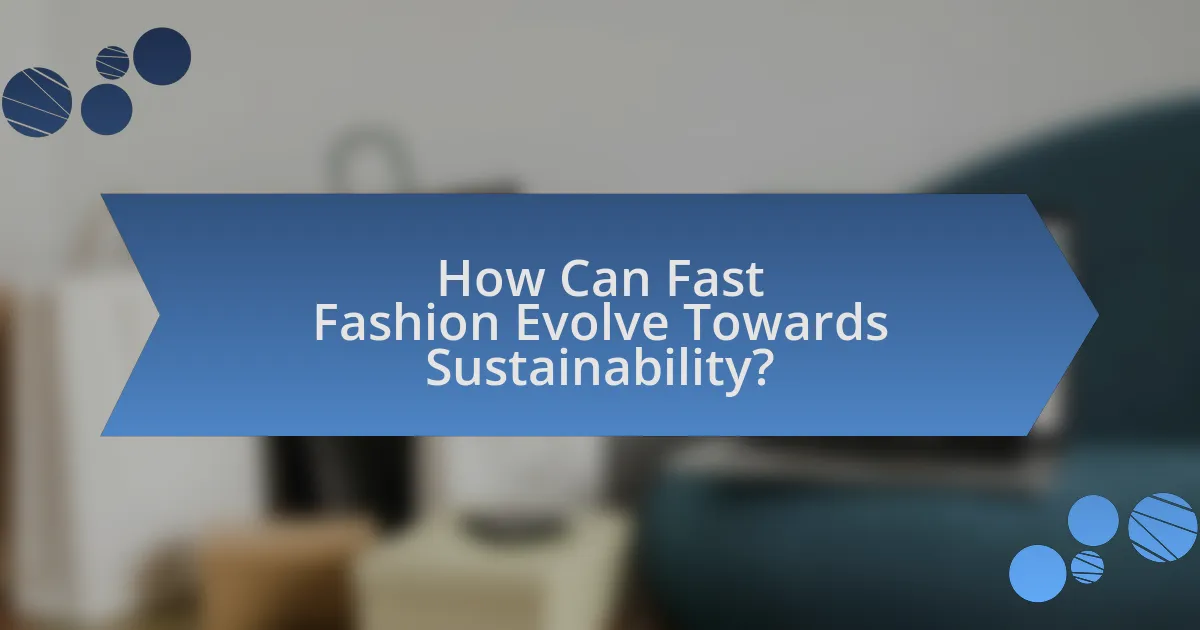
How Can Fast Fashion Evolve Towards Sustainability?
Fast fashion can evolve towards sustainability by adopting circular economy principles, utilizing eco-friendly materials, and implementing transparent supply chains. Circular economy practices, such as recycling and upcycling garments, reduce waste and extend the lifecycle of products. For instance, brands like H&M have introduced garment collection programs that encourage customers to recycle old clothes, which helps divert textiles from landfills. Additionally, using sustainable materials, such as organic cotton or recycled polyester, minimizes environmental impact; a report by the Ellen MacArthur Foundation highlights that switching to these materials can significantly reduce water usage and carbon emissions. Lastly, transparent supply chains enable consumers to make informed choices, as seen with brands like Everlane, which disclose production costs and factory conditions, fostering accountability and ethical practices in the industry.
What innovative practices are emerging in sustainable fashion?
Innovative practices emerging in sustainable fashion include the use of biodegradable materials, circular fashion models, and digital technologies for supply chain transparency. Biodegradable materials, such as organic cotton and Tencel, reduce environmental impact by decomposing naturally. Circular fashion models, exemplified by brands like Patagonia, promote recycling and upcycling, extending the lifecycle of garments. Additionally, digital technologies, including blockchain, enhance supply chain transparency, allowing consumers to track the sustainability of their purchases. These practices are supported by a growing consumer demand for eco-friendly products, with a 2021 survey indicating that 66% of global consumers are willing to pay more for sustainable brands.
How can technology aid in creating sustainable fashion solutions?
Technology can aid in creating sustainable fashion solutions by enabling efficient resource management and reducing waste through innovations such as 3D printing, AI-driven design, and blockchain for supply chain transparency. For instance, 3D printing allows for on-demand production, minimizing excess inventory and material waste. AI-driven design tools can analyze consumer preferences and optimize patterns, leading to less fabric waste during production. Additionally, blockchain technology enhances supply chain transparency, allowing consumers to verify the sustainability of materials and ethical practices, which can lead to more informed purchasing decisions. These technological advancements collectively contribute to a more sustainable fashion industry by promoting efficiency and accountability.
What role do circular economy principles play in sustainable fashion?
Circular economy principles are fundamental to sustainable fashion as they promote the reduction of waste and the maximization of resource efficiency. By emphasizing the reuse, recycling, and upcycling of materials, these principles help to minimize the environmental impact of clothing production and consumption. For instance, the Ellen MacArthur Foundation reports that transitioning to a circular economy in fashion could reduce greenhouse gas emissions by 44% by 2030. This shift encourages brands to design products with longer lifespans and to implement take-back schemes, thereby fostering a more sustainable industry overall.
How can consumers contribute to the sustainability of fast fashion?
Consumers can contribute to the sustainability of fast fashion by making informed purchasing decisions and prioritizing sustainable brands. By choosing to buy from companies that utilize eco-friendly materials and ethical labor practices, consumers can drive demand for more sustainable options. Research indicates that the fashion industry is responsible for 10% of global carbon emissions, highlighting the impact of consumer choices on environmental sustainability. Additionally, consumers can extend the lifecycle of garments through practices such as recycling, upcycling, and donating clothing, which reduces waste and promotes a circular economy.
What are practical steps consumers can take to support sustainable brands?
Consumers can support sustainable brands by prioritizing purchases from companies that demonstrate ethical practices and environmental responsibility. This includes researching brands for certifications such as Fair Trade, Organic, or B Corp, which indicate adherence to sustainability standards. Additionally, consumers can choose to buy second-hand clothing, reducing demand for new production and minimizing waste. Engaging in community initiatives that promote sustainable fashion, such as clothing swaps or local eco-friendly markets, further supports sustainable practices. According to a 2021 report by McKinsey & Company, 66% of consumers are willing to pay more for sustainable brands, highlighting the growing demand for ethical consumption.
How can consumer education impact the future of fast fashion?
Consumer education can significantly impact the future of fast fashion by fostering informed purchasing decisions that prioritize sustainability. When consumers are educated about the environmental and social consequences of fast fashion, they are more likely to choose brands that adopt ethical practices and sustainable materials. For instance, a study by McKinsey & Company found that 66% of global consumers are willing to pay more for sustainable brands, indicating a shift in consumer behavior towards sustainability. This increased demand for responsible fashion can compel fast fashion companies to adapt their business models, invest in sustainable practices, and reduce waste, ultimately leading to a more sustainable industry.
What are the best practices for brands aiming for sustainability in fast fashion?
Brands aiming for sustainability in fast fashion should prioritize the use of eco-friendly materials, implement transparent supply chains, and adopt circular economy practices. Utilizing organic cotton, recycled polyester, and other sustainable fabrics reduces environmental impact. Transparency in sourcing and production processes builds consumer trust and accountability, as evidenced by brands like Everlane, which openly share their cost breakdowns and factory locations. Additionally, adopting circular economy practices, such as take-back programs and recycling initiatives, helps minimize waste and encourages responsible consumption, as demonstrated by H&M’s garment collection program, which aims to recycle old clothing into new products.










